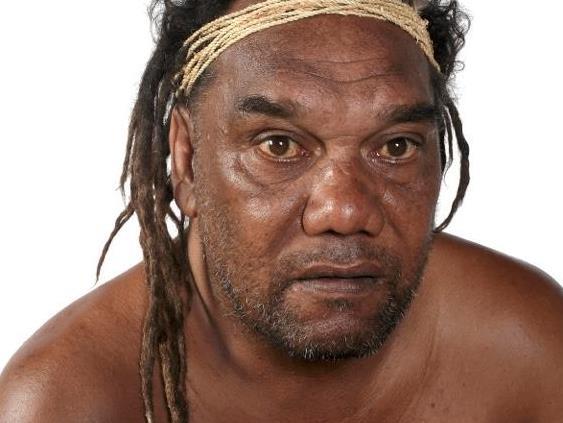I have been involved in an eighteen-year native title process with our Native Title Consent Determination granted on 24 October 2014 to the Butchulla People #2 claim. My community and clan family, the Wondunna clan, are a part of an active community in Hervey Bay and Fraser Island. My mother Shirley Foley was my mentor, and I work at a professional level to honour her. I operate in the Western art discourse, but I am Badtjala. [1]
I know my responsibility and I know my history. I am the spear point Nguthuru-Nur of my community and people see me as a representative of them.

Fiona Foley, Bearing Witness I (2009), Inkjet print on Hahnemühle paper; courtesy the artist
Empowering memory while disavowing others is an act of silencing. On Tuesday, 26 June, before a packed audience at the State Library of Victoria, I witnessed an exercise in flagrant self-promotion masquerading as research. The Australian Research Council (ARC) have awarded the project Representation, Remembrance and the Memorial to artist Brooke Andrew, who is the Chief Investigator on a two year visual arts project, with the research team comprising of Professor Marcia Langton (mentor) and Dr Jessica Neath, hosted by Monash University.
The public event I attended was titled, The Boiler Room Lecture: Walking on Bones, Empowering Memory. Speakers on stage were Mr Nelson Abiti, Ms Savina Sirik, Professor Marcia Langton, Dr Lyndon Ormond-Parker and Chair Brook Andrew. The evening started off chilly, but became increasingly steamy as the night went on. It was part of a series of events over a five day program, planned around the Representation, Remembrance and the Memorial Forum (RRM).
Professor Langton exemplified the lack of rigor underpinning the public space by doing a google search to emerge with four or five Aboriginal memorials nationally. Only one was cited in Queensland, made by her nation, the Yiman people. Other details about it were absent from the presentation.
Walking on Bones, Empowering Memory was a work in progress, which disregarded the work that has been done in this field by artists, curators and historians. Two recent and exemplary exhibitions, curated by Tess Allas and Bianca Beetson respectively, examined the Appin massacre and the Myall Creek massacre (both in NSW). The exhibition With Secrecy and Despatch was held at the Campbelltown Arts Centre in 2016, and Myall Creek and Beyond is currently on at the New England Regional Art Museum. Any discussion of this work was notably absent.
As the forum unfolded there was no introductory framing of the ARC research project by the lead investigator or analysis of the research findings since the project began in January 2016. Instead, a series of questions were asked by Brook Andrew of the panellists from Uganda, Cambodia and Australia.
The position presented was that Australia had very few frontier war monuments except for the Myall Creek Memorial and the public art commission, Standing by Tunnerminnerwait and Maulboyheenner (2016) by Brook Andrew and Trent Walter. This set the tone for how the night was controlled with the erasure of many who have worked in this area for over three decades.
Leading Queensland historian Raymond Evans argues the state of Queensland had the most massacres during the Australian frontier wars in the nineteenth and early twentieth centuries. Evans points out, ‘It is perplexing that so little seems to have been acknowledged at this seminar about the work already done in uncovering massacre information and commemoration, particularly in Queensland, where it has become very clear that the majority of Australian Frontier violence actually occurred. For instance, only a small amount of reflection points one immediately to Fiona Foley’s Massacre installation outside the Brisbane Magistrates’ Court, Timothy Bottoms’ massacre location maps in his volume, A Conspiracy of Silence and the work done by myself and Robert Ørsted-Jensen on the manifold massacres carried out. Thus, important work has already been done here and requires study and acknowledgment – this subject is in no way a tabula rasa.’
These facts were absent from any panel discussion until my interjection from the audience. The research that I and my research assistant Nona Cameron [2] carried out between 2002 and 2004 unearthed 94 Aboriginal massacre sites on the public record in Queensland, and these became the focal point for the public artwork I created outside of Brisbane Magistrates Court titled, Witnessing to Silence (2004).
When I raised this memorial, which had not been mentioned by the panellists, it was easily dismissed by Marcia Langton because it was a work made by an artist and not deemed a ‘community memorial’.
Djon Mundine, the conceptual creator behind The Aboriginal Memorial (1987) also spoke from the audience. This Aboriginal Memorial comprises of 200 hollow log coffins located at the entry to the National Gallery of Australia and is on permanent exhibition, yet it was not in the frame either. Mundine said, ‘I hadn’t been invited to take part in this discussion and in fact was surprised and insulted that this memorial was not mentioned at all in the conversations taking place.’
Other Aboriginal artists who were present in the audience, and had worked in the field of frontier wars, chose to remain silent as the silencing of Marcia Langton and Brook Andrew kept the show rolling along during an excruciating two hours of revisionist history.
To witness another layer of revisionism in Australia is a shameful step too far.
There is a discernable lack of rigour in the research being conducted through Monash University by this ARC research team of three, with their extensive international travel itinerary leading finally to Canberra where the definitive memorial to all Aboriginal frontier wars will be plonked.
One can only conclude from the content of panel discussion and the subtext of the dedicated website that the national Aboriginal memorial is yet to arrive and it will be created by artist Brook Andrew. Watch this space.
To read a response to this opinion piece visit: Bringing international perspectives to Frontier War research





